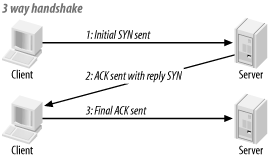6.11 TCPIP Handshaking
| < Day Day Up > |
6.11 TCP/IP HandshakingAs described above, the control segment determines the purpose of the packet. Using this segment, remote hosts can set up a communication session and disconnect the session. This part of the communication process is called the handshake . When an information path is opened between computers, the path stays open until it receives a "close" signal. Although the resources used for the session will return to the computer after a period of time, without a close signal those resources are needlessly tied up for several minutes. If enough dead connections are set up, a host becomes useless. This situation is the basis for certain denial-of-service attacks. When a server receives a packet from the Internet, it inspects the control segment to see the purpose of the packet. In order for a session to initialize, the first packet sent to a server must contain a SYN (synchronize) command. The command is received by the server and resets the sequence number to 0. The sequence number is important in TCP/IP communication because it keeps the packet numbers equal. If a number is missing, the server knows that a packet is missing and requests a resend. Once the SYN number is initialized , an acknowledgment (ACK) is sent back to the client that is requesting a session. Along with the ACK, a responding SYN is sent in order to initialize the sequence number on the client side. When the client receives the ACK and SYN, it sends an acknowledgment of receipt back to the server, and the session is set up. This example is an oversimplification, but it illustrates the basic idea of a three-way handshake (see Figure 6-4). Figure 6-4. TCP/IP handshake When a session is over and the client is finished requesting information from the server, it says goodbye . To disconnect, the client sends a FIN (final command) to the server. The server receives the FIN and sends its own FIN with an ACK to acknowledge that the session is terminated . The client sends one final ACK to confirm the termination, and the client and server separate. During the connecting and disconnecting handshakes, the client and server are constantly sending packets of information with sequence numbers. Attackers can abuse the TCP/IP handshake. For example, a TCP SYN attack generates SYN packets with random source addresses and launches them at a victim host. The victim replies to this random source address with a SYN ACK and adds an entry to the connection queue. However, since the SYN ACK is destined for a phantom host, the final step of the handshake is never completed. Thus, the connection is held open for a minute or so. Unfortunately, a flood of such spoofed packets can result in a denial-of-service condition when the target host's connection resources are overwhelmed. Worse, it is difficult to trace the attacker to his origin, as the IP address of the source is a forgery. For a public server (e.g., a web server), there is no perfect defense against such an attack. Possible countermeasures include increasing the size of the connection queue, decreasing the timeout, and installing vendor software patches to help mitigate such attacks. SYN cookies are also very effective, and there are methods to prevent your hosts from becoming relays ( zombies ) for attacks. The SYN flood attack relies on random IP source address traffic; thus, it is important to filter outbound traffic to the Internet. |
| < Day Day Up > |
EAN: 2147483647
Pages: 211